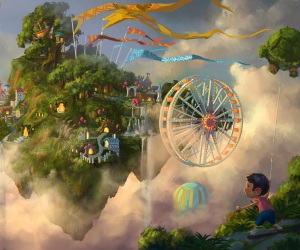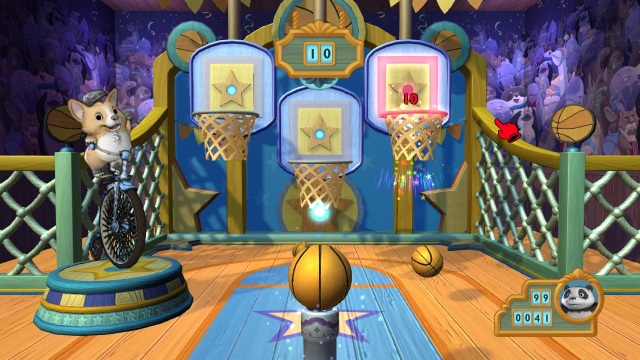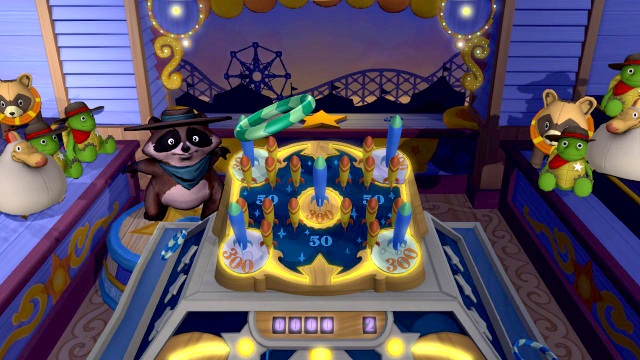Carnival Island Review
 Game: Carnival Island
Game: Carnival Island
Developer: Magic Pixel Games
Publisher: Sony Computer Entertainment
Available on: PlayStation 3 only (PlayStation Move Required)
If you are one of the people that invested in PlayStation Move early on, you’ll probably be hoping that Sony have more than a few games up their sleeve this holiday season and thankfully, they have. Along with games that offer optional Move support, Sony are publishing Medieval Moves, Move Mind Benders, an updated version of their Eyepet series called Eyepet & Friends, as well as this title, Carnival Island, which is a collection of mini-games, rounded up inside a simple play on the memories of older folks, with a Carnival. The question is however, is it worth your time and money?
STORY: Although the story is almost incidental, it is actually woven fairly nicely together with the gameplay. You will be acting out an almost dream-like carnival fantasy from the perspective of a young boy or girl, who have found a magical ticket and encountered the carnie who runs the carnival.
You also get to pick an animal, who will appear in the cut-scenes, as a kind of mascot that likes cakes. It’s delightful in its madness, but the story is really only a way to progress toward unlocking more mini-games that are locked away until you “renovate” the old broken down stalls and areas.
GRAPHICS: Most of the time will be spent actually playing the carnival games, which all look rather nice. A cartoon style mixed with the real-life carnival counterparts makes for a nice looking game, despite the lunacy of having animals as cheerleaders throughout the action. Away from the actual gameplay, the visuals are passable, but nothing special. The aforementioned cut-scenes are reminiscent of Japanese anime, right down to the howling youths and madcap antics of the characters.

SOUND: Heavy on repetition, expect to hear plenty of animal sounds and children squealing and laughing throughout. The adults in the game fare a lot better, explaining the mini-games you’ll be playing and giving a tiny amount of story exposition, explaining how you are bringing the carnival back to life, stall by stall. The music is very much the type you’d expect from a game involving carnivals, by which I mean it is rather annoying, generic, and (again) repetitive.
GAMEPLAY: As the title of the game suggests, you’ll be playing a lot of carnival games; throwing the hoop onto the bottles, flipping a coin, shooting basketballs into hoops, bowling balls at object, all the memories from a fun day out at the funfair/carnival, mostly replicated pretty accurately. There’s really nothing too deep about any of the games, and the way the difficulty laid out is either clever or annoying, depending on how you like to play games.
Initially, there are only two games available to play, and as you complete specific tasks within those games you will unlock more animals (to watch you and cheer you) and higher difficulties of the games you have already played. What this means is that if you manage to do well in an easy game, you unlock the harder games, but with a twist. What starts out as a simple game of “roll the ball into the hole” will eventually lead to a game of Snakes in the Grass, and so on. This is actually a rather clever way of extending the playtime as well as rewarding the player for doing well.
What isn’t clever however, is the loading and repetitive nature of the menus after each round of a game. With most mini-games only ever lasting around 60 seconds (maximum) you’ll grow bored of the rewards screen very quickly, with it translating your score into reward tokens (redeemable for prizes and unlockables in the game), before you have to re-play the game to achieve the tasks that will in turn unlock more games and see the same screen again. As mentioned, the load-screens are a little annoying too, and when you come out of a mini-game to go back to the island hub, you’ll see the loading screen which always feels as though it is slightly too long for a game of such low intensity on the system.

Thankfully you can spruce things up by using one of the numerous stalls that aren’t mini-games, like the photo booth which allows you to take a picture using the PlayStation Eye Camera and then play with it using modifiers that you unlock with the tickets you win from mini-games. You can make one of the pictures you mess around with replace the image for the loading screen, which takes some of the sting out of seeing it.
The method of interaction is pretty simple, be it a bowling motion or a frisbee action, there’s nothing here that is difficult or that you’ve not done before with the Move controller or Wii Remote. Generally though, the Move controls are precise and accurate (as with most Move enabled games) and even in this simple mini-game compilation you’ll find yourself thinking “I wish I played with my Move controllers more often”.
LONGEVITY: The length of a game like Carnival Island is entirely dependant on how much fun you have in the variety of mini-games on offer. Carnival Island is very suitable for younger children and their enthusiasm for the games will rub off on you, meaning that despite other irritations, you’ll probably get a couple of fun afternoons out of it. The party mode is where you’ll eventually spend most of your time, and this supports four people with either pass and play or multiple Move wands. If you can see past the loading between areas and want something to enjoy with the family, Carnival Island could last you a while, but like most mini-game compilations you’ll get bored pretty quickly – and the budget pricing reflects this.
VERDICT: There are far worse motion controlled games out there for PlayStation Move than Carnival Island, and if you have a young family (and I can’t stress that enough, over 10 years old and they won’t be interested) and are looking for a reason to charge up the Move controllers, you could do worse. Carnival Island controls well enough that it reminds the player of how accurate and wonderful PlayStation Move can be, it’s just a shame it is being reduced to mini-game compilations galore and value added content, instead of quality titles designed specifically for the peripheral.





